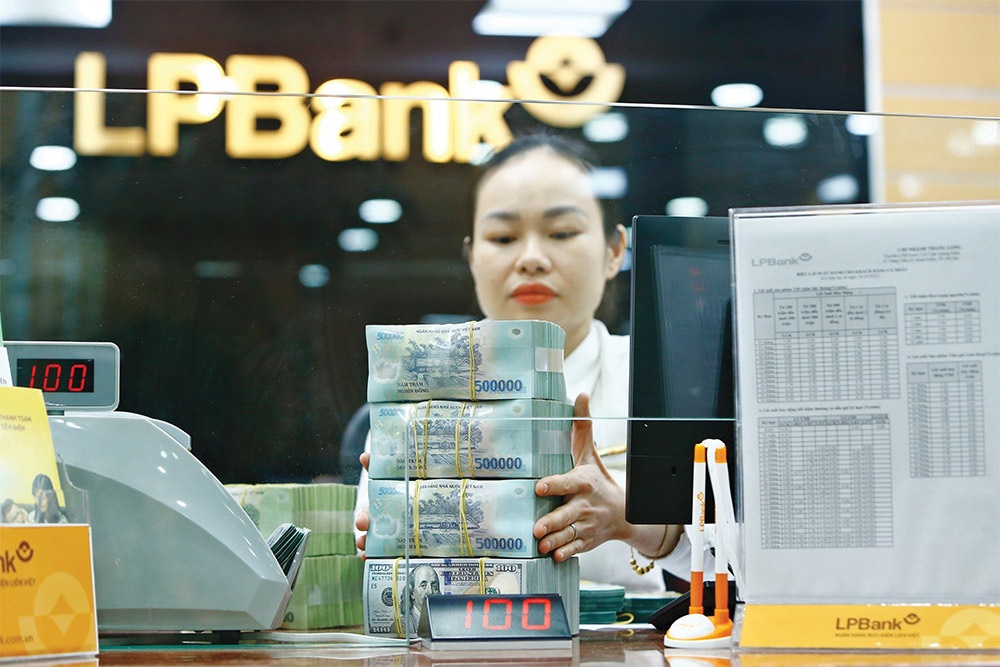Businesses wary of rising deposit rates
Savings deposit interest rates in May continued to show a slight upward trend of 20-50 basis points at commercial banks, such as MB, Techcombank, VPBank, SHB, ACB, and Sacombank, while state-owned commercial banks maintained their listed interest rates.
 |
| The State Bank of Vietnam’s monetary policy has shifted towards greater caution, Photo: Le Toan |
Specifically, small- and medium-sized commercial banks took the lead in raising deposit interest rates, followed by larger commercial banks.
MB Securities (MBS) released a report monitoring banks, indicating that the average 12-month deposit interest rate of medium and small-sized commercial banks in May increased by 0.3 per cent compared to the previous month, while larger commercial banks increased by 0.1 per cent.
State-owned commercial banks have not officially raised deposit interest rates yet. However, experts predict they will follow the trend, with the highest current deposit interest rate at 6.2 per cent per year for terms of 18 months or more.
“Credit demand will continue to increase strongly from mid-year as production and investment accelerate in the second half of the year. The accumulated industrial production index in the first five months of the year increased by 6.8 per cent on-year, and the Purchasing Managers’ Index rose to 50.3 points. Public and private investment also increased by 5 per cent,” said Le Minh Anh, an MBS analyst.
“MBS forecasts that the 12-month deposit interest rate of major commercial banks could rise by 70-100 basis points, returning to 5.3 per cent to 5.6 per cent in the second half of 2024. However, I believe lending rates will remain at current levels as regulatory bodies and commercial banks strive to support businesses in accessing capital.”
Factors exerting upward pressure on interest rate levels continued to dominate in May, as the State Bank of Vietnam’s (SBV) monetary policy shifted towards greater caution amid increasing exchange rate pressures.
“As a result, liquidity faced pressure, and the average interbank interest rate in May recorded an increase of about 30-40 basis points compared to the previous month. The prolonged tension in interbank interest rates has also been exerting pressure on funding costs or deposit interest rate levels at some commercial banks,” said a representative from BIDV.
The correlation between capital mobilisation and credit continued to narrow, as capital mobilisation growth was less positive compared to credit growth. According to the SBV, credit growth by the end of May was 2.54 per cent compared to the end of 2023, while capital mobilisation growth remained negative.
“Entering June, deposit interest rates are expected to continue a slight upward trend of about 0.1 to 0.3 per cent per year at many commercial banks, as impacting factors generally create upward pressure on interest rates,” added the BIDV representative. “The balance between capital mobilisation and credit is expected to stabilise. Credit and capital mobilisation growth are anticipated to be boosted in June.”
The SBV’s monetary policy is expected to continue being cautiously adjusted to support exchange rate stability, using open market tools like treasury bills or foreign exchange interventions as needed. Therefore, interbank interest rates are expected to remain high for a longer period, increasing pressure on funding costs at many commercial banks.
Increasing lending rates will push businesses into deeper trouble after a period of stagnation due to prolonged negative economic impacts over the past two years.
Truong Cong Quyet, director of labour supply company in the southern province of Dong Nai and the southeast region, told VIR, “In 2023, the global economy faced difficulties, leading to a sharp decline in demand in the United States and Europe, causing many businesses in Dong Nai, Ba Ria-Vung Tau, Binh Duong, and Long An to have no orders. At the same time, there was a reduction in labour, with some businesses cutting up to 80 per cent of their workforce to reduce costs to survive this period.”
However, the situation began to improve from early 2024 as businesses started recruiting.
“Some businesses have doubled their workforce compared to 2023 as orders began to focus heavily on textiles, footwear, and strong growth in electronics. Some labour supply companies have received large orders from Samsung and several Chinese companies, requiring thousands more employees, which could continue to year-end,” said Quyet.
In response to banks raising deposit interest rates again, Quyet said, “Higher deposit interest rates will naturally lead to higher lending rates, affecting the overall operations of businesses today. Increased lending rates will hasten the demise of businesses. Recently, most businesses have weathered the storm and are now trying to survive on currently favourable lending rates after two years of stagnation.”
Interest rate increases depend on each bank’s policy and the customers’ capability. However, alongside businesses recovering due to brighter business segments, some are still struggling due to a number of stagnant sectors.
Phan Thanh Tinh, director of a packaging company in Dong Nai said, “The company is still working steadily to create jobs for workers and repay bank loans. We have not yet received any notification of increased lending rates, but if they do rise, we will have to reassess the company’s production and business operations.”
 | Banks raise deposit rates but only short-term Many commercial banks raised deposit interest rates in recent months, triggering worries about the increasing pressure on the lending rates. |
 | Commercial banks cut down deposit rates Commercial banks continued to cut deposit rates on September 19 after the State bank revised down benchmark rates. |
What the stars mean:
★ Poor ★ ★ Promising ★★★ Good ★★★★ Very good ★★★★★ Exceptional
Related Contents
Latest News
More News
- As global green supply chain reshapes, will Vietnam be left behind? (December 19, 2025 | 08:00)
- Banks gear up for massive capital increases (December 18, 2025 | 17:04)
- Securing capital and efficiency for Vietnam’s 2026-2030 growth ambitions (December 17, 2025 | 10:00)
- Energy sector in need of blended finance mechanisms (December 17, 2025 | 09:00)
- Vietnam still has room to mobilise capital for sustainable growth (December 17, 2025 | 08:57)
- Long-term capital seen as key hurdle to green growth (December 16, 2025 | 08:00)
- Gold prices swing amid tax debate and import uncertainty (December 15, 2025 | 18:04)
- Agribank frames bank credit as catalyst for green growth (December 15, 2025 | 17:59)
- Vietnam’s green transition demands collective financial action (December 15, 2025 | 12:00)
- VIR workshop highlights capital and policy for sustainable development (December 15, 2025 | 11:00)

 Tag:
Tag:





















 Mobile Version
Mobile Version